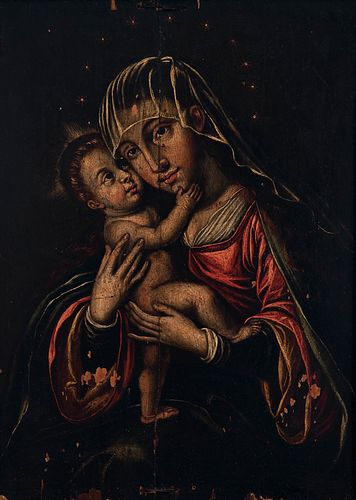Hispano-Flemish school; XVI century. "Virgin and Child". Oil on panel.
Lot 25
About Seller
Setdart Auction House
Carrer Aragó 346
Barcelona
Spain
Setdart Subastas was born in 2004 and is currently the first online art auction in Spain with solidity, prestige and reliability guaranteed by our more than 60,000 users. Setdart has a young, dynamic and enterprising team ready to successfully manage the purchase and sale of art works through custom...Read more
Estimate:
EUR€2,200 - EUR€2,500
$2,291.67 - $2,604.17
Absentee vs Live bid
Two ways to bid:
- Leave a max absentee bid and the platform will bid on your behalf up to your maximum bid during the live auction.
- Bid live during the auction and your bids will be submitted real-time to the auctioneer.
Bid Increments
| Price | Bid Increment |
|---|---|
| EUR€0 | EUR€10 |
| EUR€200 | EUR€25 |
| EUR€500 | EUR€50 |
| EUR€1,000 | EUR€100 |
| EUR€3,000 | EUR€200 |
| EUR€5,000 | EUR€500 |
| EUR€10,000 | EUR€1,000 |
| EUR€20,000 | EUR€2,000 |
| EUR€50,000 | EUR€5,000 |
About Auction
By Setdart Auction House
Nov 24, 2021
Set Reminder
2021-11-24 09:00:00
2021-11-24 09:00:00
America/New_York
Bidsquare
Bidsquare : Old Masters, Day 1
https://www.bidsquare.com/auctions/setdart-auction-house/old-masters-day-1-7873
Setdart Auction House sofia@setdart.com
Setdart Auction House sofia@setdart.com
- Lot Description
Hispano-Flemish school; XVI century. "Virgin and Child". Oil on panel. Presents breakage on the board. Board reinforced with veneer and gramas. It has faults and repainting. Measurements: 37 x 26.5 cm; 53 x 42.5 cm (frame). In the foreground is the image of Mary, dressed in a red tunic and hair covered by a transparent cloth that lets you see through it. The Virgin holds and brings to her cheek the Child Jesus, placed between his mother's arms, completely naked and innocent, moving one of his hands towards his mother's cheek, holding it with gentleness. Jesus directs his gaze towards the Virgin, however, she looks directly at the viewer as if warning that her son will be the savior, who will sacrifice his life. As usual in the Flemish school, the attention to the quality of the fabrics and their coloring stands out above all. The composition is also very common in this common, deriving from the iconographic patterns established around the representation of the Virgin of the Milk, also known as the nourishing Virgin or wet nurse, of the Rest or Bethlehem, is a Marian iconography in which Mary is represented breastfeeding the Child. It is based on the story of the Grotto of the Milk, in Bethlehem, where the tradition says that the Virgin gave suckling to the Child, and a drop was spilled on a rock, which changed its color and became white. However, iconographically it is a very ancient theme, which has its origin in the mother goddesses of the ancient religions of the Near East and the Greco-Latin world: Isis with Horus, the Milky Way from Hera's milk, etc. This theme was incorporated into Paleo-Christian art, with examples being found as early as the 2nd century. In Byzantine art it received the name of Galactotrofusa, and was a recurring theme in icons. In Latin Christianity the invocation became very popular in the last centuries of the Middle Ages. It was particularly frequent in the Sienese school of the Trecento, and soon spread throughout Western Europe. However, its representation was limited after the Council of Trent, for reasons of modesty, although Baroque painters continued to deal with it, and it even reached the colonial schools.
- Shipping Info
-
In-house shipping available. Please inquire at admin@setdart.com.
-
- Buyer's Premium



 EUR
EUR CAD
CAD AUD
AUD GBP
GBP MXN
MXN HKD
HKD CNY
CNY MYR
MYR SEK
SEK SGD
SGD CHF
CHF THB
THB















